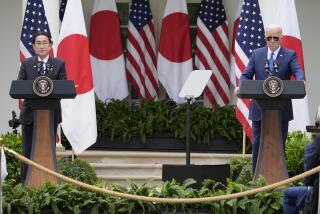U.S. and Japan Already Taking Some Big Steps
- Share via
Summitry may ease some tensions temporarily, but if it raises expectations too much, it may be counterproductive.
That’s been the case frequently in U.S. relations with Japan. President Reagan and Prime Minister Yasuhiro Nakasone have no problem agreeing that Japan should take steps to lessen its massive trade deficit with this country. Yet the deficit keeps growing. Protectionists charge Japan with window dressing. Just last week, as the President was preparing for the economic summit that begins today, the House Ways and Means Committee passed legislation that would impose quotas on Japan and others if they fail to reduce their trade surpluses with the United States.
The irony in this is that anyone who steps back from the controversy for a moment has to realize that the “dispute” between the two countries is no longer really a dispute at all. Hence, instead of being pessimistic, there’s good reason for hope.
Yes, the numbers promise to remain bad. And, yes, many Americans continue to believe that Japan is unfairly jeopardizing their jobs. But a dispute implies disagreement over whether there’s a problem, who’s causing it and what should be done about it. Essentially, political and business leaders of the two nations have long agreed on all three points. The extent of the agreement isn’t always clear, considering the persistent tough language on both sides, but a close examination of what’s happening shows that it exists.
It was obvious to both sides a long time ago that Japan could not continue to build a bigger and bigger surplus with the United States. Each side, however, had a different version of who was at fault. U.S. leaders complained of unfairness. Japan benefited from this country’s basic free trade philosophy while keeping in place barriers to outsiders seeking to do business in Japan, they argued. Japanese leaders, meanwhile, blamed much of the problem on the failure of U.S. companies to compete effectively. Manufacturing costs, they figure, run at least 10% higher here than in Japan.
Many leaders on both sides now accept the truth of both arguments. Nakasone has demonstrated his agreement with the U.S. position by his efforts to bring basic reform to the Japanese economy, both by opening the doors to more imported goods and by promising to stimulate more domestic consumption. There’s still concern in the United States that Nakasone won’t, or can’t, push this fast enough for their liking, but few can doubt the political risk that the prime minister has been willing to take.
At the same time, the acceptance of Japan’s criticism of U.S. business is spreading rapidly in this country. Again, the evidence is in actions. Company after company is reassessing its structure, its competitive effectiveness, its entrepreneurial spirit. Investment in cost-saving equipment has been stronger in recent years. Many companies have pushed down break-even points. Once again, this won’t produce massive successes overnight, but they will come.
One more factor in the dispute was the undervalued yen. That, too, has been dealt with. There’s disagreement over how much more adjustment, if any, is needed, but a 30% swing in the yen’s value is nothing to sniff at.
The question now is how rapidly the trade numbers will change. Japanese officials point out that they could eliminate every barrier and U.S. companies probably still couldn’t sell nearly as much there as Japanese companies can sell here. But that’s not really the issue. The issue is fairness, and the fact that Japan is responding on that point is going to make it much tougher on American protectionists.
Longer term, the picture is brighter. Even some Japanese now recognize that a revitalization of U.S. manufacturing prowess is well under way. In fact, one reason Japanese firms are setting up factories in the United States is that they see this rebound coming and figure they’ll have to be located here to compete effectively.
It is true that Japan still lacks the confidence to drop its trade barriers entirely. And it is also true that some U.S. industries never will regain a competitive edge. None of that, however, changes the fact that both sides are responding. It is unreasonable to expect much more.
More to Read
Get the L.A. Times Politics newsletter
Deeply reported insights into legislation, politics and policy from Sacramento, Washington and beyond. In your inbox twice per week.
You may occasionally receive promotional content from the Los Angeles Times.










